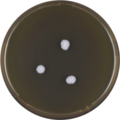| Aspergillus restrictus | |
|---|---|
| Scientific classification | |
| Kingdom: | Fungi |
| Division: | Ascomycota |
| Class: | Eurotiomycetes |
| Order: | Eurotiales |
| Family: | Aspergillaceae |
| Genus: | Aspergillus |
| Species: | A. restrictus |
| Binomial name | |
| Aspergillus restrictus | |
| Synonyms [2] | |
| |
Aspergillus restrictus is a species of fungus in the genus Aspergillus . It is from the Restricti section. [3] The species was first described in 1931. [1] It is xerophilic, frequently found in house dust. Studies have suggested that it is an allergen implicated in asthma. [4] [5] In 2016, the genome of A. restrictus was sequenced as a part of the Aspergillus whole-genome sequencing project - a project dedicated to performing whole-genome sequencing of all members of the genus Aspergillus. [6] The genome assembly size was 23.26 Mbp. [6]

